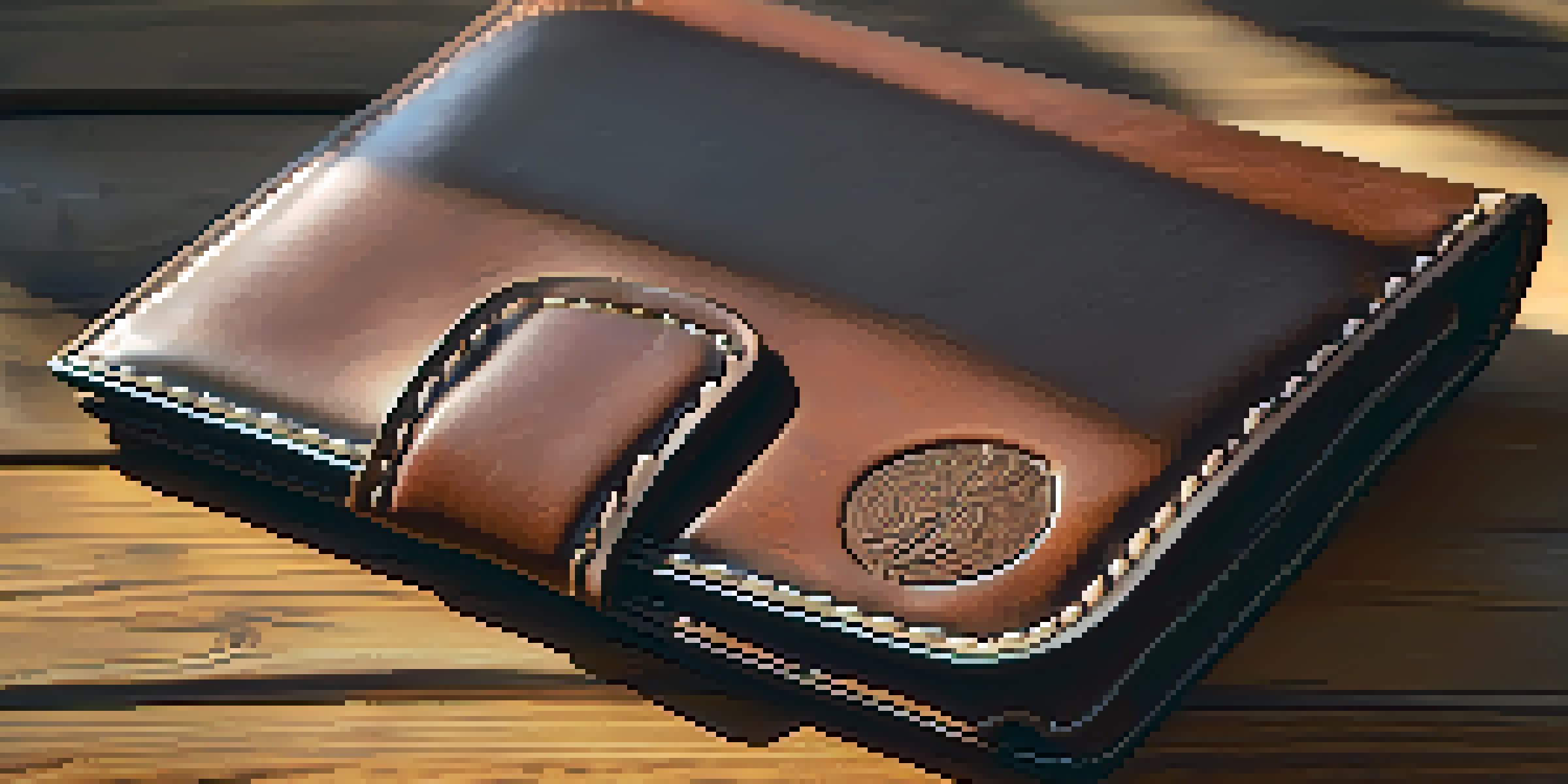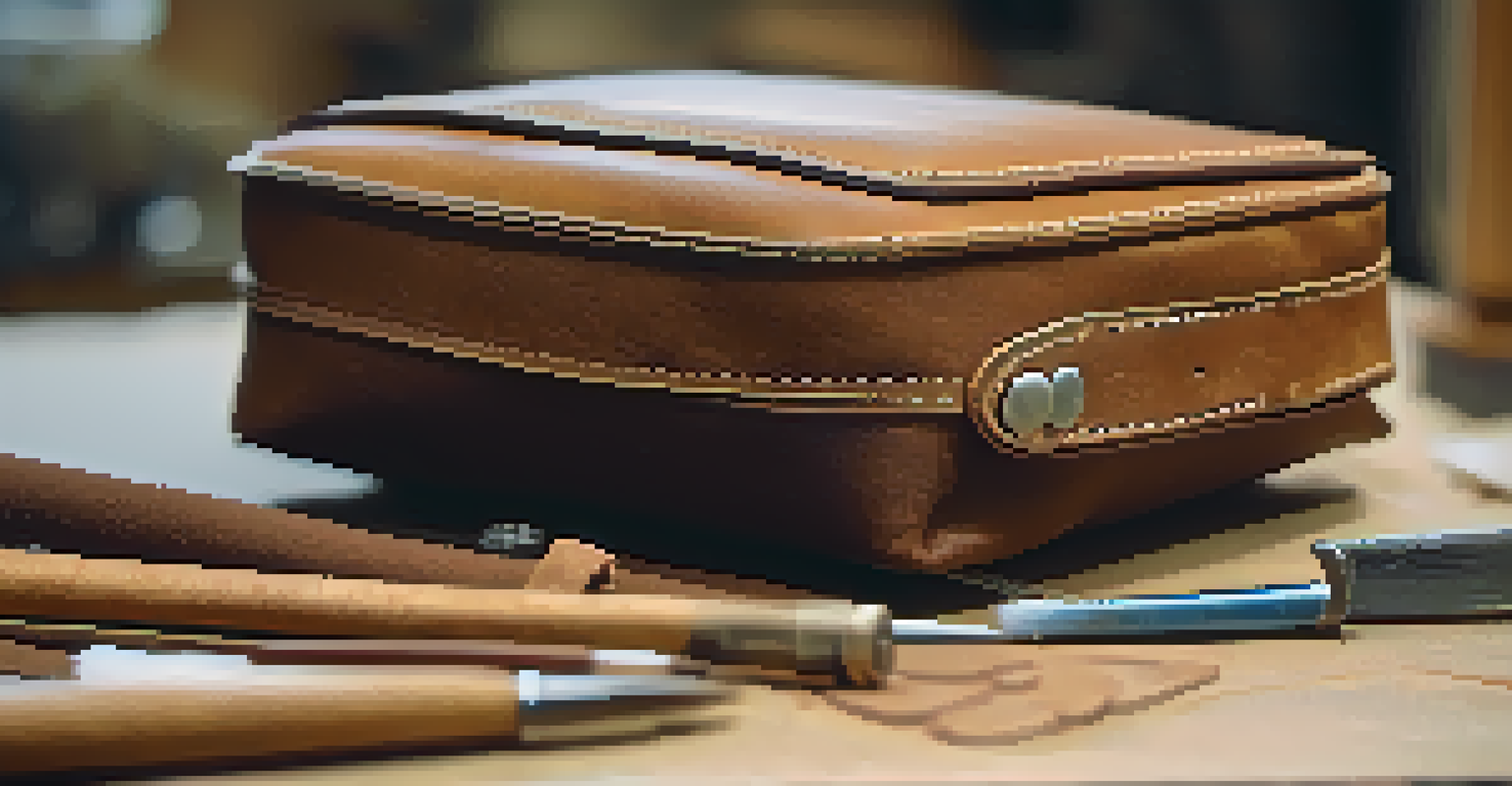How to Stitch Leather: Techniques and Tips for Beginners

Understanding the Basics of Leather Types
Before diving into stitching, it's essential to recognize the different types of leather. Full-grain leather, for instance, is known for its durability and natural look, while top-grain leather is a more refined option that still offers strength. Knowing the characteristics of each type will help you choose the right material for your project.
The craftsman’s hand is the most powerful tool he has.
Additionally, you have suede and bonded leather, both of which serve unique purposes. Suede offers a soft texture, ideal for bags and soft furnishings, while bonded leather, made from leather scraps, is often more affordable but less durable. Your choice of leather will influence not only the final look but also the stitching techniques you’ll use.
By familiarizing yourself with these options, you can make informed decisions that align with your project goals. This foundational knowledge sets the stage for successful leather stitching and ensures your efforts yield a product you'll be proud of.
Essential Tools for Leather Stitching
Having the right tools is crucial for any leather stitching project. At a minimum, you'll need a sharp utility knife for cutting, a cutting mat to protect your surfaces, and a ruler for precise measurements. Don’t forget about needles and thread; waxed thread is recommended for its strength and durability.

You may also want to invest in a stitching awl, which creates holes for your needle, making the process smoother. A stitching pony can be useful for holding your leather pieces together while you work. These tools may seem basic, but their quality can significantly impact your stitching experience.
Know Your Leather Types
Understanding different leather types, like full-grain and suede, is essential for selecting the right material for your project.
Finally, consider adding a few optional items like edge tools and finishes to enhance your project. While these tools might not be necessary for beginners, they can elevate your work as you grow in skill and confidence.
Choosing the Right Thread and Needle
Selecting the right thread and needle is key to achieving strong, beautiful seams. For leather projects, a thicker, waxed thread is ideal, as it resists wear and tear while providing a polished finish. Popular choices include nylon or polyester threads, both known for their durability.
Success is the sum of small efforts, repeated day in and day out.
When it comes to needles, a leather needle with a wedge-shaped tip is essential. This type of needle easily penetrates leather without damaging the fibers, ensuring clean holes for stitching. Be sure to match your needle size with your thread thickness for the best results.
Experimenting with different combinations of thread and needle types can lead to unique finishes and textures, so don’t hesitate to try out various options. Over time, you'll discover what works best for your specific projects and preferences.
Mastering Basic Stitching Techniques
As a beginner, starting with basic stitching techniques will help you build a solid foundation. The saddle stitch is one of the most popular methods, known for its strength and durability. It involves threading two needles through the same hole from opposite sides, creating a robust seam that holds up well over time.
Another technique to explore is the running stitch, which is simpler and works well for less demanding projects. This method involves sewing in and out of the leather in a straight line, making it an excellent choice for beginners looking to practice their skills.
Essential Tools for Success
Having the right tools, such as a utility knife and waxed thread, significantly impacts the quality of your leather stitching.
With practice, you'll become more comfortable with these techniques, allowing you to tackle more complex projects. Remember, the key to mastering any skill is patience and persistence, so don’t be afraid to make mistakes along the way.
Preparing Your Leather for Stitching
Properly preparing your leather before stitching is crucial for achieving the best results. Start by cutting your leather pieces accurately, using a utility knife and a cutting mat to ensure clean edges. Take your time here; precision will pay off later in the stitching process.
Next, consider skiving the edges, which means thinning them down for a smoother finish. This step can minimize bulk and create a more professional look once your project is complete. Use a skiving knife or a sharp utility knife to carefully shave off the edges.
Lastly, marking your stitching lines with a ruler and a pen will help guide your needle and keep your stitches even. This preparation sets the stage for a successful stitching experience and can make a significant difference in the final appearance of your project.
Enhancing Your Stitching with Finishing Techniques
Finishing techniques can elevate your leather projects from good to great. After stitching, consider burnishing the edges, which involves rubbing them with a slicker or a piece of canvas. This step not only smooths the edges but also gives them a polished look that enhances overall durability.
You might also want to apply a leather conditioner or finish to protect your project from moisture and wear. A good conditioner keeps the leather supple and prevents cracking, ensuring your hard work lasts for years to come.
Avoid Common Stitching Mistakes
Being aware of common mistakes, like using incorrect needle sizes or rushing measurements, can help you improve your leatherworking skills.
Experimenting with different finishes can lead to unique textures and appearances. This creative freedom allows you to put your personal touch on every project, making each piece truly one-of-a-kind.
Common Mistakes to Avoid in Leather Stitching
Even seasoned leatherworkers make mistakes, so don’t be too hard on yourself as a beginner. One common error is using the wrong needle or thread size, which can lead to weak seams or unsightly holes. Always double-check your materials before starting to ensure compatibility.
Another mistake is rushing through the measuring and cutting process. Taking shortcuts here can result in uneven pieces that don’t fit together well. Remember, patience is key—measure twice and cut once to avoid costly errors.

Finally, neglecting to practice can hinder your progress. Like any craft, leather stitching requires time and effort to perfect. Embrace the learning process and enjoy the journey; every project is an opportunity to grow your skills.